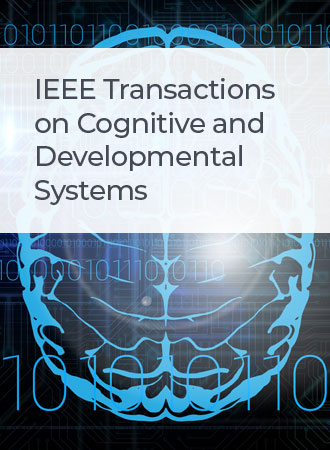基于具有短期可塑性的单层二维突触的仿生尖峰神经网络用于听觉脑干处理
IF 4.9
3区 计算机科学
Q1 COMPUTER SCIENCE, ARTIFICIAL INTELLIGENCE
IEEE Transactions on Cognitive and Developmental Systems
Pub Date : 2024-08-29
DOI:10.1109/TCDS.2024.3450915
引用次数: 0
摘要
在物种的声音定位中,短期抑制(STD)对维持耳间时间差(ITD)的敏感性起着重要作用。本文提出一种利用二维突触装置模拟生物声音定位的仿生尖峰神经网络(SNN)。采用双端单层装置作为人工突触,其时间电导变化模拟了突触的STD。α突触电流和漏性整合-火(LIF)神经元模型用于实际皮层操作。采用侧抑制和上橄榄核(SON)来提高灵敏度,补偿耳间音阶差(ILD)引起的干扰,扩大声强范围。通过将固态STD突触和生物似是而非的皮层模型与基于itd的重合检测机制相结合来模拟听觉脑干处理,我们的SNN实现了声音定位,分辨率为人类水平的1°。本文章由计算机程序翻译,如有差异,请以英文原文为准。
Biomimetic Spiking Neural Network Based on Monolayer 2-D Synapse With Short-Term Plasticity for Auditory Brainstem Processing
In the sound localization of species, short-term depression (STD) plays an important role in maintaining interaural timing difference (ITD) sensitivity. In this article, a biomimetic spiking neural network (SNN) utilizing 2-D synaptic devices for mimicking biological sound localization is presented. A two-terminal monolayer device is used as the artificial synapse, whose temporal conductance change mimics the STD of a synapse. Alpha synaptic current and leaky integrate-and-fire (LIF) neuron models are used for realistic cortical operation. Lateral inhibition and superior olivary nucleus (SON) are adopted to increase the acuteness, to compensate for the interaural level difference (ILD)-induced disturbance, and to enlarge the sound intensity range. By combining solid-state STD synapses and bio-plausible cortical models with an ITD-based coincidence detection mechanism to mimic the auditory brainstem processing, our SNN achieved sound localization with a human-level resolution of 1°.
求助全文
通过发布文献求助,成功后即可免费获取论文全文。
去求助
来源期刊

IEEE Transactions on Cognitive and Developmental Systems
Computer Science-Software
CiteScore
7.20
自引率
10.00%
发文量
170
期刊介绍:
The IEEE Transactions on Cognitive and Developmental Systems (TCDS) focuses on advances in the study of development and cognition in natural (humans, animals) and artificial (robots, agents) systems. It welcomes contributions from multiple related disciplines including cognitive systems, cognitive robotics, developmental and epigenetic robotics, autonomous and evolutionary robotics, social structures, multi-agent and artificial life systems, computational neuroscience, and developmental psychology. Articles on theoretical, computational, application-oriented, and experimental studies as well as reviews in these areas are considered.
 求助内容:
求助内容: 应助结果提醒方式:
应助结果提醒方式:


